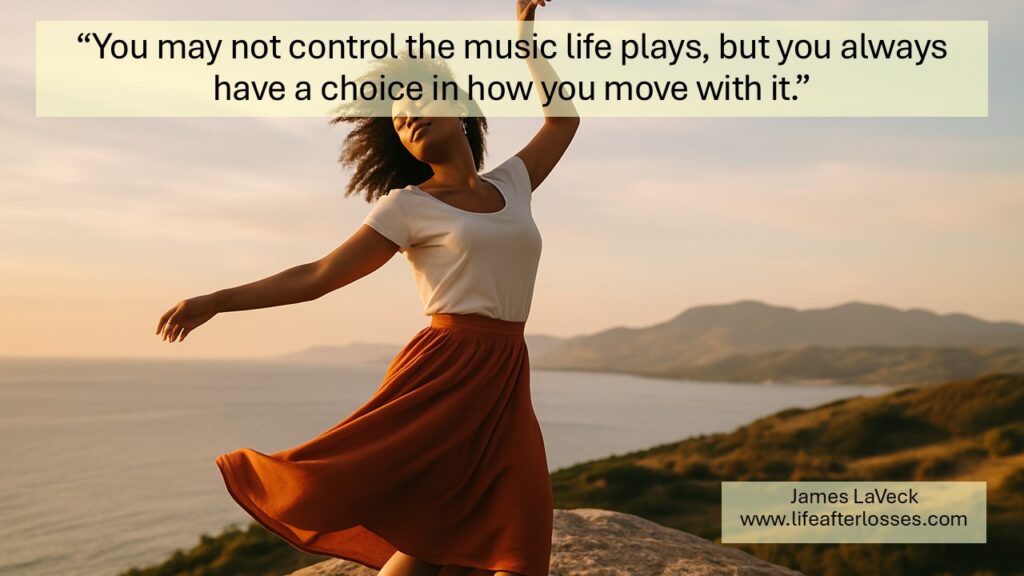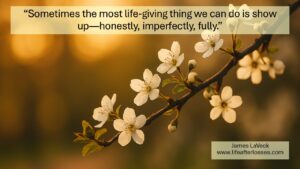After my first loss, I really had no clue how to express my emotions. I won’t delve into all the reasons for that—cultural expectations, generational silence, or the simple fact that I grew up in a world where boys were told not to cry. Whatever the cause, the result was the same: I felt emotions deeply, but I had no way to give them voice.
So I turned to music.
I created a series of mixtapes—three cassettes, nearly seventy songs. They became the soundtrack of my healing. Each track was chosen for a reason, whether it echoed my grief, reminded me of love, or hinted at resilience I didn’t know I had. It started with “The Dance” by Garth Brooks and, months later, ended with “Move On” by George Michael. To this day, when I revisit the digital versions, I can feel the same arc of emotion. It’s like my own jukebox musical of survival.
And that’s what led me to a quote I came across recently:
We can’t always choose the music life plays for us, but we can choose how we dance to it.
The older I get, the more I realize it wasn’t just about music. It was about finding creative ways to express what words alone can’t carry.
Why Creativity Matters in Grief
I’ve shared before how grief distorts the mirror. Every flaw looks magnified. Every failure feels final. When we’re in the middle of loss, words often fail us (at least for me) because they’re too small, too clumsy for what we’re holding.
That’s where creativity steps in. No, it doesn’t “fix” the pain, but it helps by giving it form. It lets us move what’s inside of us into the world, so we’re not carrying it all alone. My mixtapes weren’t polished art (though they did look good with the liner notes); they were an expression of my journey.
For someone else, that expression might look like:
- Sketching late at night, letting the pencil wander.
- Cooking meals that remind them of home.
- Taking photos of the ordinary, things like the morning coffee, the empty chair, or the sunlight on the floor.
- Writing letters that are never sent.
- Dancing in the living room, even if no one else sees.
- Creativity doesn’t ask for perfection. It asks for presence.
Practical Ways to Begin
If you’re wondering how to start, here are a few small but powerful practices:
Build Your Own Soundtrack
Make a playlist that mirrors your journey. Start with one song that says, this is how I feel right now. Add others as you go. Over time, you’ll have a musical map of your healing.
Try Journaling—But Loosely
Don’t worry about spelling, grammar, or even full sentences. Just write what comes out. It could be fragments, lists, or even doodles. The point isn’t to be eloquent—it’s to release. Looking for ideas? You can check out the prompts in Grief Recovery for Adults or get the companion PURPOSE Journal.
Create Something with Your Hands
Plant something in the garden, knit a scarf, build a puzzle, paint with messy colors. Tangible actions can ground us when emotions feel untouchable.
Practice “Tiny Creativity”
You don’t need a masterpiece. Try five minutes. One photo. A single verse. A small sketch. Small acts build evidence that expression is possible, even when words are hard. And if you have this belief that you’re not a creative person, this will help prove that you can be.
Choosing How We Dance
That quote (we can’t always choose the music life plays for us) rings true because loss has a way of forcing songs we never wanted onto the playlist. Illness, death, endings, disappointments. None of us would choose them.
But here’s the part we do get to choose: how we respond. Whether we stay frozen or let ourselves move again, however clumsy it feels at first. Whether we keep the grief locked inside or allow it to take shape outside of us—in music, in art, in writing, in movement.
For me, it started with cassettes. For you, it might start with something entirely different.
The form doesn’t matter. What matters is that it gives your heart a way to breathe.
Your Turn
This week, I want to challenge you to explore your own form of creative expression. You don’t need to be “good” at it. You don’t even need to share it with anyone. Just give yourself permission to create something that reflects where you are, not where you think you should be.
- Write the unsent letter.
- Paint the messy picture.
- Curate the playlist.
- Sing in the shower.
- Dance in your kitchen.
- Take one photo a day of something that moves you.
Because this creativity isn’t about producing art, it’s about releasing life. And sometimes, it’s about survival.
I didn’t know it back then, but those mixtapes were more than music. They were my proof that even in grief, I still had a voice. And 30 years later, I can still feel it.
So I’ll leave you with this last thought: You may not control the music life plays, but you always have a choice in how you move with it.
What’s one creative outlet that’s helped you process emotions—or one you’d like to try?




